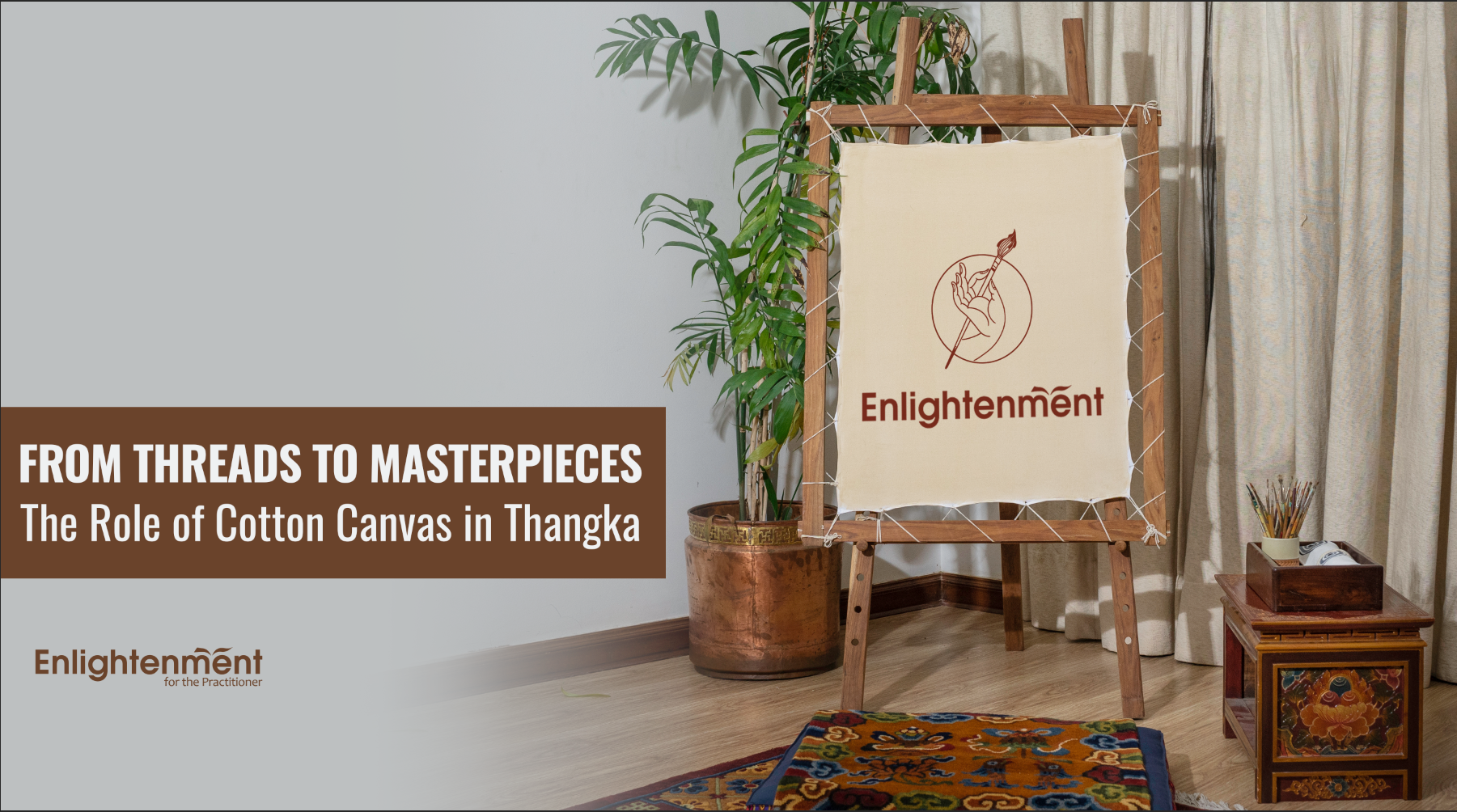Thangka's Timeless Beauty: The Magic of Cotton Canvas Painting
Thangka, a cherished art form deeply rooted in Tibetan Buddhist culture, has held immense significance in the Himalayan region for centuries. Among the diverse options available for crafting these intricate masterpieces, cotton canvas emerges as a favored and time-honored choice.
Key Takeaways
- Cotton canvas is favored in Thangka art for its durability and versatility.
- The history of Thangka art is deeply intertwined with the use of cotton canvas.
- Meticulous canvas preparation is crucial to ensure the artwork's longevity and vibrancy.
- Cotton canvas provides unmatched advantages in the realm of Thangka art.
- Historical Context of Cotton Canvas in Thangka
Thangka's Ancient Roots
Thangka art, originating in Tibet, has been significantly shaped by neighboring cultures such as Indian, Nepalese, and Chinese artistic traditions.
Transition To Cotton
As Thangka paintings' popularity grew, a demand for a sturdy and versatile canvas arose. Given its abundance in the region, cotton emerged as the logical choice. Its adaptability and durability positioned cotton canvas as the optimal foundation for these intricate artworks, ultimately becoming the standard practice.
Why Cotton Canvas?
- Unmatched Durability
Cotton canvas is renowned for its robustness and longevity. When meticulously primed and cared for, a Thangka painting on cotton canvas can endure for generations, retaining its vividness and intricate details becoming a cherished family heirloom.
- Perfect for Detailed Artwork: Smooth Surface
Artists favor cotton canvas primarily because of its smooth surface, which enables the precise rendering of intricate details, thereby capturing the essence of Thangka art. Its distinct texture and weave also influence the brushwork and paint texture.
- Cost-Effectiveness
While maintaining high quality, cotton canvas is more affordable than other materials like silk, making it a preferred choice for artists and patrons.
Click here to view our High Quality Thangka Paintings On Cotton Canvas
- Absorbency and Paint Adherence
Cotton's absorbent nature enables adequate paint adhesion, capturing the vibrant and meaningful colors essential in Thangka painting, where each hue carries profound symbolism.
The Art of Preparing Cotton Canvas
The preparation of the cotton canvas is a crucial step in Thangka art. This process ensures that the canvas is smooth, impurities-free, and ready to hold the paint.
- Stretching the Canvas
Initially, the canvas is stretched over a frame, ensuring it stays tight and wrinkle-free, creating an impeccable painting surface. Preparing cotton canvas is a meticulous process, commencing with the necessary cotton fabric that must be meticulously stitched on all sides to a wooden or metal frame, securing the cloth firmly in place.
- Priming the Surface
A chalk and animal glue mixture, with the right consistency (neither too thick nor too runny), is applied as a primer. This layer smoothens the surface and enhances the paint's adhesion to the canvas. It should be used on both sides and allowed to dry.
- Sanding for Perfection
Once the primer has dried, the surface undergoes sanding to achieve a flawlessly smooth finish, ensuring precise capture of every detail in the Thangka painting.
After completely drying one side, it is moistened through gentle rubbing with a smooth stone or cloth and then left to cure. The exact process is then repeated on the other side, continuing until the desired level of smoothness is attained.
Comparing Cotton Canvas with Other Materials
| Material | Durability | Cost | Surface Texture |
| Cotton Canvas | High | Moderate | Ultra-smooth |
| Silk | Moderate | High | Smooth |
| Linen | Moderate | High | Slightly Textured |
| Jute | Low | Low | Rough/ Coarse |
The table clearly shows that while other materials have advantages, cotton canvas strikes a harmonious balance between durability, cost-effectiveness, and surface texture, making it the premier choice for Thangka paintings.
The Role of Cotton Canvas in Thangka Preservation
Protecting Thangkas from Environmental Damage: Cotton canvas is a protective barrier, shielding Thangkas from environmental elements that may cause deterioration.
Canvas as a Guardian of Ancient Art: In preserving ancient Thangkas, cotton canvas emerges as a guardian, safeguarding the spiritual heritage passed down through generations.
Handmade Cotton Canvases at Enlightenment Thangka
At Enlightenment Thangka, our commitment to the art of Tibetan Thangka painting extends beyond the brushstroke. We take immense pride in crafting our very own cotton canvases, meticulously designed to meet the unique requirements of this sacred art form.
The Essence of Thangka Painting
Thangka painting transcends mere artistic expression; it is a profound spiritual practice. These intricate artworks serve as visual representations of Vajrayana deities and play a vital role in the journey of Buddhist practitioners. To ensure that our canvases resonate with the essence of Thangka painting, we uphold a set of core principles:
- Right Motivation: Our canvas preparation begins with the purest motivation, deeply rooted in reverence for the spiritual significance of Thangka art. We approach this process with utmost respect and unwavering mindfulness.
- Ethical and Moral Values: Ethics and morality form the cornerstone of our canvas crafting. We uphold ethical standards in every phase, ensuring that our materials and techniques align with the spiritual principles of Tibetan Buddhism.
- Artistic Creativity: Thangka art demands the highest level of artistic creativity. We take immense pride in the artistic finesse of our canvas preparation, striving to depict forms that faithfully honor their spiritual importance.
- Clear Conveyance of Values: Clarity is of paramount importance. Our canvases are meticulously designed to convey the profound values and symbolism of Thangka painting, serving as a bridge for both initiates and newcomers to the practice.
More Than Just Canvas
These canvases are more than mere surfaces for paint; they serve as gateways to inner peace and spiritual growth. They are not just tools for creating art but also vehicles for experiencing liberation from ego and the illusory nature of the world.
The art of Thangka stands as a testament to the rich cultural and spiritual heritage of the Tibetan region. Cotton canvas, with its myriad advantages, serves as the perfect foundation, ensuring that these masterpieces not only enchant with their beauty but also endure the test of time. For artists, patrons, and enthusiasts alike, grasping the significance of cotton canvas in Thangka art deepens the appreciation of these exquisite creations.


